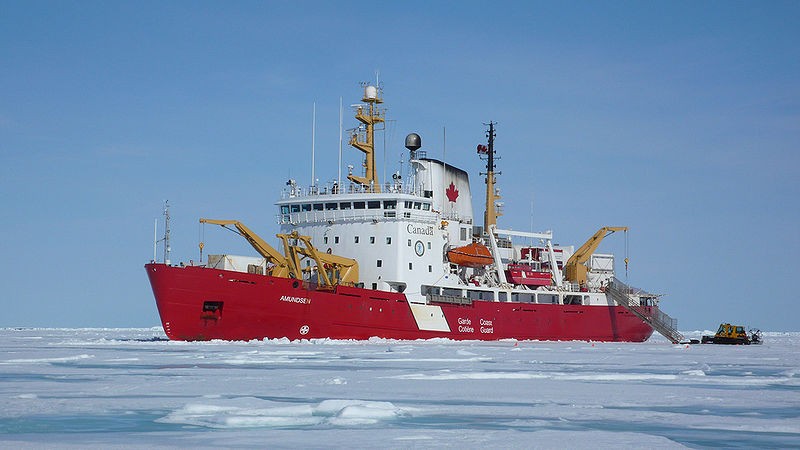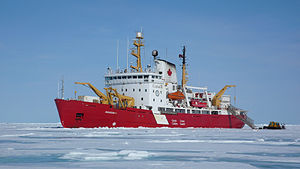The Canadian Coast Guard research vessel Amundsen is on its way back to the Arctic after spending last year in dry-dock for repairs.
The ship was launched on Friday in St. Catharines, Ont. There were significant repairs to its engines and new generators were installed.
A news release said it was a $6 million contract for Seaway Marine and Industrial.
“This is great news for ArcticNet,” said Keith Levesque, a co-ordinator with the network of researchers studying climate change.
“It's great news for the Canadian science community and international science community that does research up in the Arctic just because the Canadian icebreaker ship Amundsen has been the flagship of Canadian Arctic Research for the past 10 years.”
Levesque said the Amundsen will head to Labrador at the end of July before continuing northwest through the Arctic.
Research this summer will cover everything from phytoplankton to the atmosphere.
Amundsen icebreaker dry-docked for the year
Inspection finds problems with four of six engines on vessel used for Arctic research
CBC News
Posted: Jan 31, 2012 9:46 AM ET
The Canadian Coast Guard's Amundsen icebreaker will be dry-docked in Quebec this year after a recent Transport Canada inspection found four of its six engines cracked.
"We were not expecting this on the Amundsen so early because the ship has less sea time,” said Johnny Leclair, regional fleet director for the Canadian Coast Guard.
“We were kind of thinking that we might have problems in the future but the future came rapidly for us."
The 33-year-old vessel is used by ArcticNet, a group of scientists that studies the impacts of climate change on the coastal Canadian Arctic.
ArcticNet has used the Amundsen since 2002 after it was renovated into a first class floating laboratory with $30 million worth of equipment on board.
The Amundsen was scheduled for 80 days at sea this summer. Some of the critical work will still be done using other vessels.
"Some of those projects definitely have to wait till next year and we'll just have a larger program in 2013," said Martin Fortier, executive director of ArcticNet.
It’s a blow for researchers, said Yves Gratton, a professor at the Institut national de la recherche scientifique in Quebec, who has worked on the Amundsen since 2002.
"It's major because research like that costs millions every year and it's our only way to go to the Arctic and take samples," he said.
Fortier said when the Amundsen is fixed, the work will resume.
"We certainly intend to operate her for science for another decade at least," he said.
The Coast Guard says they do not know how long the repairs will take, or what they will cost, but last year the same type of repairs on the Amundsen's sister ship, the Pierre Radisson, cost about $15 million.

Length: 322' (98 m)
Weight: 5,911 tons
Launched: 1979
Beam: 64' (20 m)
Builders: Burrard Dry Dock Ltd., Burrard Dry Dock
fyi... | ||||||||||||||||||||||||||||||||||||||||||||||||||||||||||||||||||||||
CBC News
Posted: Oct 12, 2011 7:48 AM CT
Last Updated: Oct 12, 2011 10:35 AM CT
The flagship of Canada's fleet of icebreakers will be going south for repairs after suffering mechanical problems during a scientific mission in the Arctic Ocean.
The Louis St. Laurent was working in the thick ice on Sept. 19 when crew members felt an abnormal vibration in the stern.
"Upon further investigation with its autonomous underwater vehicle, it was determined there was a problem with the centre propeller," said Brian LeBlanc, the Coast Guard's fleet director for the Arctic.
The 42-year old icebreaker was on a joint mission with the U.S. Coast Guard to continue surveying and mapping the continental shelf beyond 200 nautical miles for Canada's submission to the Commission on the Limits of the Continental Shelf under the United Nations Convention on the Law of the Sea.
When the St. Laurent broke down, the U.S. Coast Guard cutter Healy escorted it out of the ice.
From there the icebreaker sailed eight days under its own power to Cambridge Bay, Nunavut, where it has sat offshore since Sept. 27.
Repairs needed
"Unfortunately the on-site repairs were not successful, so we're faced with bringing the ship through the Northwest Passage and down to the south where we can put it into dry dock to complete the repair," said LeBlanc.
The St. Laurent has two working propellers to make the voyage.
LeBlanc says the scientific mission in the Arctic Ocean was completed before the breakdown, and the ship was then scheduled to be on stand-by for icebreaking duties in the high Arctic until its return to St. John’s, N.L., in mid-November.
There are other Coast Guard ships around Nunavut that will pick up the St. Laurent’s duties.
The St. Laurent is scheduled to be replaced in 2017 by a new $720 million polar-class icebreaker that will be named the John G. Diefenbaker.


No comments:
Post a Comment
Enter your comment(s) here...